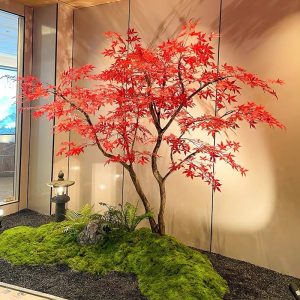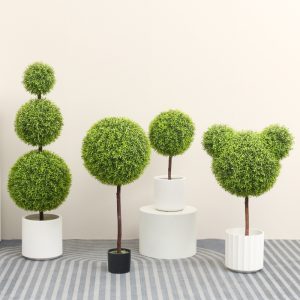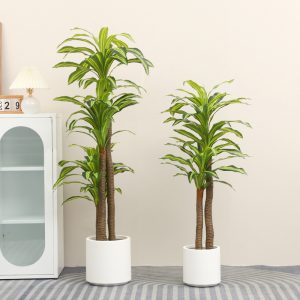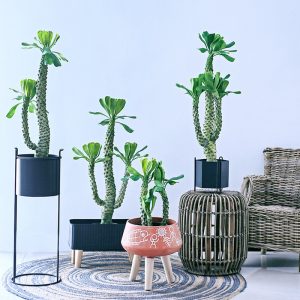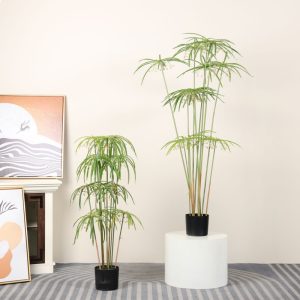8:30 a.m., Wednesday, in the office building of the London financial district, the soft sound of keyboards tapping filled the air. Amy from the marketing department paused when she pushed open the glass door—on the front desk’s long wooden table, a bunch of plants with heart-shaped leaves were basking in the slanted sunlight, their deep and light green veins blending like a painter’s careful strokes.
“What’s this? It was empty last week,” she bent down to take a closer look, her sleeve brushing against the edge of a leaf without stirring up any dust. Lucy, the administrative manager, walked out from the break room with a coffee cup, smiling as she tilted her head, “That’s the artificial pothos plant we just put here yesterday. Doesn’t it feel just like the one in the café downstairs?”
Sunlight filtered through the blinds, casting fragmented light spots on the leaves. Amy gently touched the leaf veins with her fingertips, feeling the soft warmth unique to the faux material, and even the tiny fuzz on the underside of the leaves was clearly visible. “It’s almost indistinguishable from the real thing,” she couldn’t help but walk around the long table. “No wonder the clients who passed by earlier were all staring at it.”
Lucy put her coffee cup down and lightly brushed the topmost new leaf, “Last week during the department meeting, didn’t everyone complain that the office felt like a cold glass box? Now that we’ve added this touch of green, even the air feels fresher.”
The front desk’s long table was replaced with walnut wood last year. The artificial pothos plant was placed in a frosted glass pot, positioned at just the right height, level with the front desk computer screen.
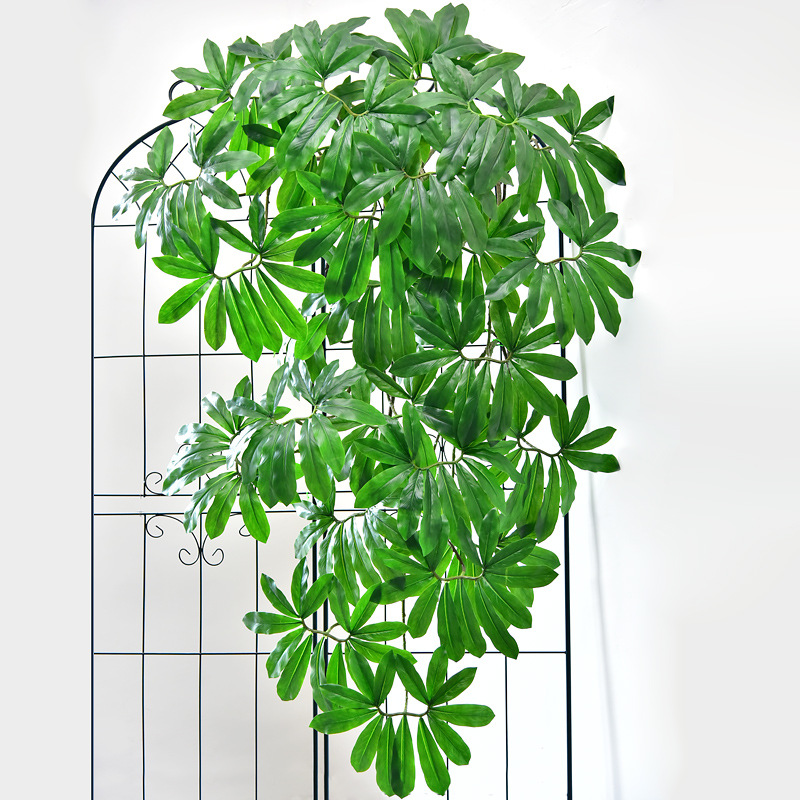
“Look at the curled edges of this leaf,” Amy gently lifted a half-open new leaf, “They’ve even made the tiny brownish detail at the edges.” Lucy nodded, smiling: “The supplier said they used high-quality PU material that’s not only waterproof and fade-resistant but also treated with UV protection.”
At 3:00 p.m., the sunlight softened. As the light passed through the faux pothos leaves, delicate leaf shadows were cast on the wall. Sophia from the design department, holding her sketchpad, immediately pulled out her phone and took a picture: “These shadows are perfect for a background image!”
She leaned in and sniffed the leaves, suddenly raising her eyebrows in surprise: “It even has a faint herbal scent?” Lucy took a small bottle of essential oil from the drawer: “I secretly sprayed some citrus herbal fragrance.”
“Are these artificial pothos leaves real?” Tom from customer service put down his documents and squatted by the plant to study it. “The pothos on my balcony always drops leaves, and cleaning up is a hassle.”
Lucy handed him a glass of lemon water: “That’s exactly why we chose artificial pothos. You see, we get so many visitors at the front desk every day. These faux plants don’t need watering or fertilizing, and no leaves ever fall off.”
Amy pulled up the order records on her phone: “I compared three suppliers before choosing this one. And the root system is wrapped in natural moss—up close, you can’t tell it’s fake.”
Mark suddenly pointed to the underside of the leaves: “The vein pattern is exactly the same as the one in the real pothos pictures I saw on Amazon!”
“Actually, I initially wanted to go with real plants,” Lucy said, watching the light spots dancing on the leaves, “But the cleaning lady said the real pothos we had before turned yellow in less than two weeks because of the air conditioning. These artificial plants are much easier to take care of—no worries about root rot in the rainy season or dried-up leaves when the heating is on in winter.”
On Thursday morning, Amy noticed Susan from the finance department was taking photos of the artificial pothos on the front desk. “Are you going to show this to Lily?” Amy asked softly. Susan nodded with a smile: “She said she wanted a plant for her office, so I’m sending this to her for reference.”
At lunch, several colleagues gathered around the long table, eating sandwiches. Sunlight filtered through the gaps between the leaves, landing on their salad boxes. “I used to think eating lunch in the office felt like being on a conveyor belt,” the intern, Jesse, said, “Now, with these plants around, it feels more like having a picnic in a garden.”
The biggest surprise was the change in the meeting room. Lucy had placed a small artificial pothos plant next to the projector, and the formerly plain white wall suddenly had more texture.
On Friday evening, during overtime, Tom noticed a light had gone out in the admin department. But strangely, the outline of the artificial pothos was still clear in the dark. “It even stands out in the dim places,” he took a photo and sent it to the work group.
Susan looked at the photo and said, “Actually, our department’s window side has very poor lighting. These artificial plants don’t mind, they can stay green even in the shady corners.”
On Monday morning, when Lucy opened the office door, she noticed a new friend next to the artificial pothos at the front desk—a small artificial pothos with thinner leaves. The marketing manager walked by and laughed, “I was browsing the supplier’s website over the weekend and found they have a lot of options for office faux green plants. Next time, should we decorate the break room too?”
The suggestion immediately got everyone’s response. Amy pulled out the supplier’s catalog: “They also have versions with trailing vines, which can be hung above filing cabinets. The smaller pots are perfect for office desks.”
Tom suddenly pointed to a set in the catalog: “This set with the pot is perfect for us!” Lucy was already calculating the budget: “If we put one in front of each department, the best part is they don’t require any special care, and we can reuse them at the end of the year. It’s way cheaper than buying real plants.”
At lunch, everyone gathered around the computer, selecting styles. “How about creating a plant corner? We could display all kinds of faux green plants, and it might even become a popular photo spot.”
Before leaving on Friday, Lucy sent a picture to the work group: the front desk at sunset, the artificial pothos leaves outlined in a golden glow, with the newly added artificial pothos trailing vines gently resting on the file rack. The caption read: “Next week, we’ll add more green to the office.”
Amy smiled as she looked at the photo. In just five days, the artificial pothos had already become an essential part of the office.
“At first, I was worried everyone would think fake plants were insincere,” Lucy said while packing up her things. “But now, it seems that the greenery that can stay vibrant long-term is actually more thoughtful than the real plants that need constant care but always seem to wither.” She dusted off the faux leaves as if they had gathered dust.
As Amy walked out of the office building, she glanced back. The bright green on the glass curtain wall was still clearly visible in the dusk. She suddenly began to look forward to next week—the artificial monstera, the artificial fiddle-leaf fig in the meeting room, and the small artificial pothos plant on her desk, all waiting to spread their greenery to every corner of the office.








